Zic2 controls cerebellar development in cooperation with Zic1
- PMID: 11756505
- PMCID: PMC6757594
- DOI: 10.1523/JNEUROSCI.22-01-00218.2002
Zic2 controls cerebellar development in cooperation with Zic1
Abstract
Mouse Zic genes encode zinc finger proteins and are expressed in the developing and mature CNS. Reduced expression of Zic2 in mice results in spina bifida and holoprosencephaly. However, the disruption of Zic1, a strong homolog of Zic2 that has an overlapping expression pattern, results in cerebellar malformation with no apparent abnormalities in the forebrain or in posterior neuropore closure. Here we revealed that Zic2 and Zic1 cooperatively control cerebellar development by regulating neuronal differentiation. Both Zic1 and Zic2 are expressed in the precursor cells of the granule neuron and the neurons in cerebellar nuclei. Mice carrying one mutated Zic1 allele together with one mutated Zic2 allele (Zic1(+/-)Zic2(+/kd)) showed a marked cerebellar folial abnormality similar to, but distinct from that found in mice homozygous for the Zic1 mutation (Zic1(-/-)). The Zic1(+/-)Zic2(+/kd) cerebellum is missing a lobule in the anterior vermis and has a truncation of the most posterior lobule. Expression of transverse zonal markers is shifted anteriorly in the developing cerebellum, indicating that the anterior part of the cerebellum is poorly developed. Abnormalities in the developing Zic1(+/-)Zic2(+/kd) cerebellum share the following features with those of the Zic1(-/-) cerebellum: a preceding reduction of cell proliferation in the anterior external germinal layer, a reduction in cyclin D1 expression, and enhanced expression of the mitosis inhibitors p27 and p16, and enhancement of Wnt7a expression. These results indicate that Zic1 and Zic2 may have very similar functions in the regulation of cerebellar development.
Figures


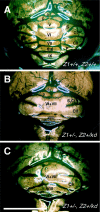
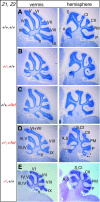
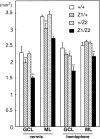

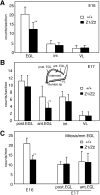
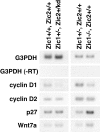

References
-
- Altman J, Bayer SA. Development of the cerebellar system. CRC; New York: 1997. Comparative anatomy of the cerebellum, an evolutionally perspective. pp. 3–20.
-
- Aruga J, Yokota N, Hashimoto M, Furuichi T, Fukuda M, Mikoshiba K. A novel zinc finger protein, Zic, is involved in neurogenesis, especially in the cell lineage of cerebellar granule cells. J Neurochem. 1994;63:1880–1890. - PubMed
-
- Aruga J, Nagai T, Tokuyama T, Hayashizaki Y, Okazaki Y, Chapman VM, Mikoshiba K. The mouse Zic gene family: homologues of Drosophila pair-rule gene odd-paired. J Biol Chem. 1996;271:1043–1047. - PubMed
-
- Aruga J, Mizugishi K, Koseki H, Imai K, Balling R, Noda T, Mikoshiba K. Zic1 regulates the patterning of vertebral arches in cooperation with Gli3. Mech Dev. 1999;89:141–150. - PubMed
Publication types
MeSH terms
Substances
LinkOut - more resources
Full Text Sources
Medical
Molecular Biology Databases
Research Materials
